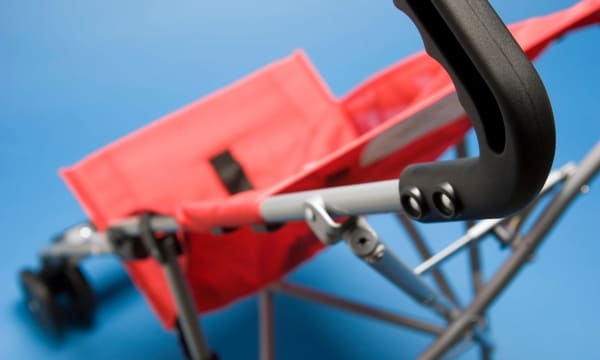Why is the umbrella stroller design obsolete (for most), and why rather go for an ultra-compact?

TL;DR: The not-that-sturdy design of an umbrella stroller was overcome in almost every aspect by the modern, smaller-folding ultra-compact buggies. The single handle of a travel buggy is also a huge asset, one-hand maneuverability-wise. Still, both types should be picked with their travel- and occasional-use in mind and won't work as well for everyday needs (compared to something full- or mid-size).

The invention of an umbrella stroller by Owen Finlay Maclaren in 1965 was most certainly ground-breaking. The old-school view of children's transportation as something comfortable, equipped with rocking suspension - but heavy, large, protective - changed completely. The bulky, beautiful prams were not practical for the then-modern parents. Their want to travel with the child was followed by the worldwide success of finally-compact umbrella buggies by the British Maclaren brand (later copied by other brands). And Owen's umbrella-folding design based on aeronautical engineer's skill and application of a Spitfire aircraft undercarriage design took the world by storm. Still, the umbrella type of stroller is a synonym of something handier, lightweight, compact, good for traveling/car boot...

What changed, you ask? Well, everything, starting with the world and the life in it. We always want more - something smaller, handier, with better maneuverability, easier manipulation... and that is where an ultra-compact stroller was born. Slowly and continually, the lightweight, quick-fold, mid-sized strollers with a forward-facing seat were reduced in size and then became as small as to fit the airplane overhead compartment for carry-on luggage. Even if a continual process, 'the revolution' happened in 2012, with the first airline-approved carry-on buggy, ultra-compact Babyzen Yoyo's invention. And the more we traveled, the more ultracompact pushchairs and buggies were designed and became available (and more budget-friendly).
How is a travel, ultracompact buggy a better option? It all, of course, depends on what your preferences and needs are (as always). In general, however, there are a few main points where the lightweight, compact strollers NOT folding like an umbrella have a strong advantage.
First is the handlebar area. A single handlebar, not two separate golf club-like handles, is so much sturdier. The single bar means extra support to the chassis - thus, a stroller not that wobbly as an umbrella buggy will become. And the cheaper the umbrella stroller is, the sooner the wobbliness happens.
Another thing with the single handlebar is much better maneuverability. You CAN push your ultra-compact with one hand easily, but a separate-handlebars umbrella model means you will endure a single-handed push only a few minutes at the most. In general, it's simply not comfortable since the center of gravity is different with two handles on the sides.
The fold is a second strong advantage. An umbrella stroller folds in one point and is ALWAYS rather long after folding. So even if a thin package, it might not fit a smaller car boot, and if so, often with difficulty. An ultracompact usually folds in thirds, and in the end, you get an oblong (square or rectangle-like) shape similar to a larger handbag. That, you'll fit truly in any car trunk, and often in a large bag as well (or you'll get a carry bag included with the stroller).
The fold has its downsides as well - more joints mean more possibly problematic points, so if mistreating or overloading your ultra-compact, there are more points where it can break. On the other hand, an umbrella stroller also has many connections and joints, so it's not very different there either. That is why neither type is suitable for regular use on rough terrain, nor for any kind of overloading, overstraining the chassis - even with a bag on the handlebar(s).
To not sound biased, I want to mention a few other disadvantages of an ultracompact stroller. The truth is that most of them, if not all, apply to an umbrella buggy as well, so they don't really make a difference when choosing between these two.
* Always think of an ultra-compact model being designed mainly for traveling - and that is its purpose. It's never an everyday, all-day, all-terrain ride; you'll damage it. The wheels' size corresponds to the same philosophy - only a few models have larger-than-tiny wheels, and still, ven those are not the best for any kind terrain, longevity-wise.
* The small size before and after folding also means 'don't expect crazy much space in the seat'. It's not a stroller for many comfortable hours for a large child - it's an
_as-simple-as-it-gets, almost-emergency, smallest-possible A to B transportation mean__
. In particular, the backrest will be short(-ish), so a tall kid might not be as comfy in the headrest department (good news, the canopy, at least, is usually quite high). Overall, it would be a big mistake thinking of an ultra-compact as a spacious, naps- and larger children-friendly tool. It is not.
* And, lastly - size-associated is also the size of secondary parts like the sun hood or the shopping basket. Don't expect the canopy to be huge (yes, there are exceptions like the Maclaren Atom with a large one, but there will be other downsides - such as not-so-upright sitting position or no bumper bar). Most certainly don't ask for a basket larger than the basic "tiny". Even if it were larger, the chassis' small size shouldn't be overstrained with loads of shopping. Not even if the manufacturer claims high weight capacity.
So - should you buy an ultra-compact buggy over an umbrella stroller? In my opinion, yes, definitely. However, it should be purchased with traveling, keeping in the car boot, and occasional errands in mind, certainly not as an alternative to a full-size stroller or a mid-size forward-facing pushchair.
If you're still curious about the dangers of terrain- and everyday-use of an ultra-compact, there's another article concerning the topic of ultra-compact strollers and their best use.
